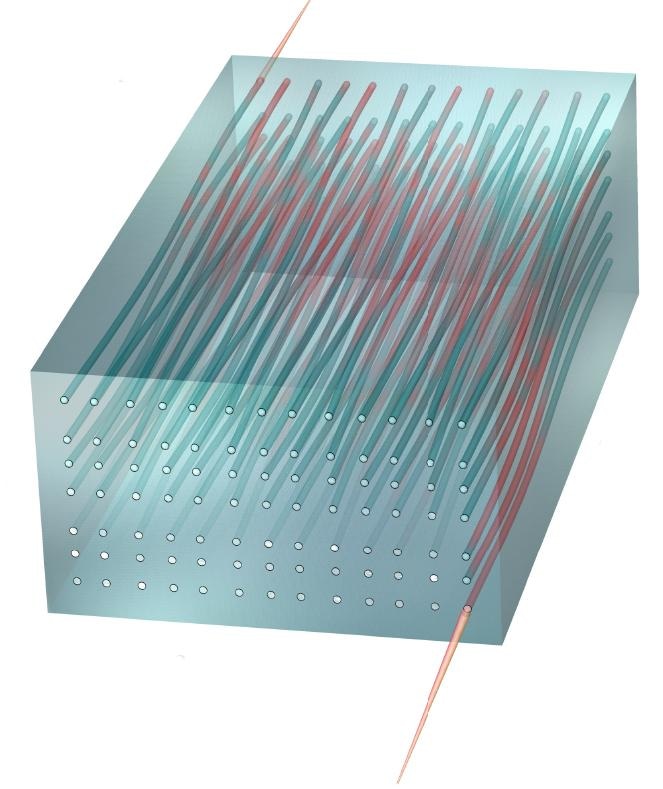Jan 5 2018
For the first time, physicists have developed a two-dimensional experimental set-up that enables the analysis of materials' physical characteristics, which were hypothesized to occur just in four-dimensional space.
An international research team including scientists from Penn State, ETH Zurich in Switzerland, the University of Pittsburgh and the Holon Institute of Technology in Israel, have shown that the behavior of light particles can be matched with hypotheses related to the four-dimensional interpretation of the “quantum Hall effect,”.
 Illustration of light passing through a two-dimensional waveguide array. (Photo credit: Rechtsman laboratory, Penn State University)
Illustration of light passing through a two-dimensional waveguide array. (Photo credit: Rechtsman laboratory, Penn State University)
A paper reporting on the research was published in the Nature journal on January 4, 2018, together with a paper authored by a different team from Germany. They demonstrate that a similar mechanism can be adopted to render a gas containing ultracold atoms to exhibit four-dimensional quantum Hall physics.
“When it was theorized that the quantum Hall effect could be observed in four-dimensional space,” stated Mikael Rechtsman, who is one of the authors of the paper and Assistant Professor of Physics, “it was considered to be of purely theoretical interest because the real world consists of only three spatial dimensions; it was more or less a curiosity. But, we have now shown that four-dimensional quantum Hall physics can be emulated using photons—particles of light—flowing through an intricately structured piece of glass—a waveguide array.”
An electric charge sandwiched between two surfaces behaves efficiently similar to a two-dimensional material. Upon cooling the material to near absolute-zero temperature and subjecting it to a strong magnetic field, its conductivity level becomes “quantized,” that is, it is fixed to a basic constant of nature and cannot be altered. “Quantization is striking because even if the material is ‘messy’—that is, it has a lot of defects—this ‘Hall conductance’ remains exceedingly stable,” stated Rechtsman. “This robustness of electron flow—the quantum Hall effect—is universal and can be observed in many different materials under very different conditions.”
Such a quantization of conductivity, which was earlier reported in two-dimensions, cannot be seen in a normal three-dimensional material. However, in the year 2000, researchers theoretically showed that a similar quantization can be seen in four spatial dimensions. In order to model such a four-dimensional space, the team developed arrays of waveguides, where every waveguide is actually a tube behaving similar to a wire for light. Each “tube” is engraved through high-quality glass with a high-powered laser.
Multiple such waveguides are engraved to be closely spaced using a single piece of glass to develop the array. The team adopted a latest method to encode “synthetic dimensions” into the waveguide positions. Put differently, the complicated arrangements of the waveguide positions function like a manifestation of the higher dimensional coordinates. The team encoded two extra synthetic dimensions into the complicated geometric structure of the waveguides and could model the two-dimensional system to include totally four spatial dimensions. Then, they evaluated the way light traveled through the device and discovered that it behaved exactly as per the four-dimensional quantum Hall effect.
Our observations, taken together with the observations using ultracold atoms, provide the first demonstration of higher-dimensional quantum Hall physics. But how can understanding and probing higher-dimensional physics have some relevance to science and technology in our three-dimensional world? There are a number of examples where this is the case. For example, ‘quasicrystals’—metallic alloys that are crystalline but have no repeating units and are used to coat some non-stick pans—have been shown to have ‘hidden dimensions:’ their structures can be understood as projections from higher-dimensional space into the real, three-dimensional world. Furthermore, it is possible that higher-dimensional physics could be used as a design principle for novel photonic devices.
Mikael Rechtsman, Co-Author and Assistant Professor of Physics
Apart from Rechtsman, the team included Jonathan Guglielmon from Penn State; Oded Zilberberg from ETH Zurich; Sheng Huang, Mohan Wang, and Kevin Chen from the University of Pittsburgh; and Yaacov E. Kraus from the Holon Institute of Technology.
The U.S. National Science Foundation, the Charles E. Kaufman Foundation, the Alfred P. Sloan Foundation, and the Swiss National Science Foundation supported the study.